The forgotten Zara class cruisers
When speaking of “Zara”, the name (outside a clothing brand) in naval history resonates as an Italian heavy cruiser class, which always comes to mind to navy nerds. Not far away, fifty years earlier, another “Zara” class was active… in the Austro-Hungarian Navy.
These were a far cry to the splendid Italian ships, a small fraction of their displacement, but still “cruisers” nevertheless for some authors and listed as such by wikipedia. Officially they were however “torpedo vessels”, and in truth small station torpedo boat destroyers.
With their elegant lines they almost looks like luxury yachts in disguise, made for cruising the calm and sunny Adriatic sea. Failing miserably to reach their designed speed however (they were as fast on sail alone!) the role they played in WW1 was virtually nonexistent. In short, they are now forgotten ships, to the point the Conway’s forgotten them in their 1860-1905 edition and published them on the next. SMS Lussin derived frpm the same program and is integrated here by commodity but was almost her own class.
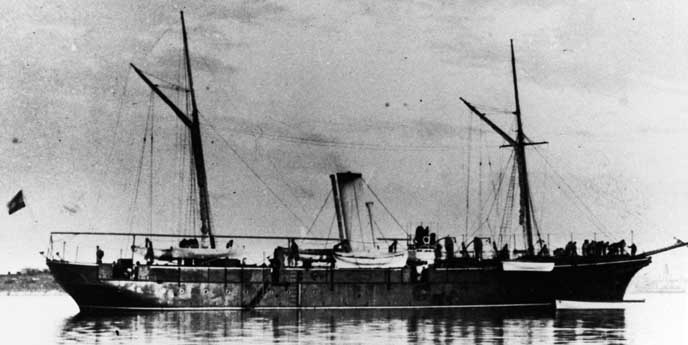
SMS Zara as built
Development of the new torpedo vessel
The Zara class torpedo vessels proceeded of the need to use torpedo and at the same time fight against very early torpedo boats, at a time Austria-Hungary was at the forefront of torpedo innovation, through its local British office of Thornycroft, invented and breveted by an Austrian inventor, Johann Luppis.
In 1875, the idea of a torpedo boat was no longer a fantasy and naval staffs experimenting with dangerous spar torpedo launches started to see in the torpedo launcher fast boat something less reckless and perilous to use. For the Austro-Hungarian staff which Navy was just in the making, this was a perfect opportunity to re-establish a balance of forces with an equally young but much larger Italian Navy, a potential rival at the time, although there were more concerns about a still powerful Ottoman Navy.
Whatever the case, ships were thought of to fight against boats carrying torpedoes, having them deterred away for larger and more valuable assets, using guns and torpedoes. The idea was born as a second choice by Marinekommandant (Navy Commander) of the Austro-Hungarian Navy, Friedrich von Pöck, forced to renounce to obtain financing for his ironclads. He turned to more “asymetric” forms of warfare in which the recent torpedo was centerpiece, alongside naval mines. The feeble navy at the time could only be considered in modern terms as a “green water” one, made for coastal and defensive actions, with a added deterrence of several fortifications along the coast.
The torpedo carrier ship went in genesis for some time, but Von Pöck agreed with the Torpedoversuchs-Kommission that this was the way forward. After hearing a report from Fregattenkapitän Hermann von Spaun, naval attache to Britain, which observed the torpedo gunboat HMS Vesuvius in construction, the design was precised. The first specifications came from the Artillerie-Kommission and Schiffbau-Kommission in reunion on 15 January 1875. At the same time, Von Pöck ordered a first Torpedoboot from Britain, soon followed by five more. This was the start of the development of the Austro-Hungarian torpedo boats.
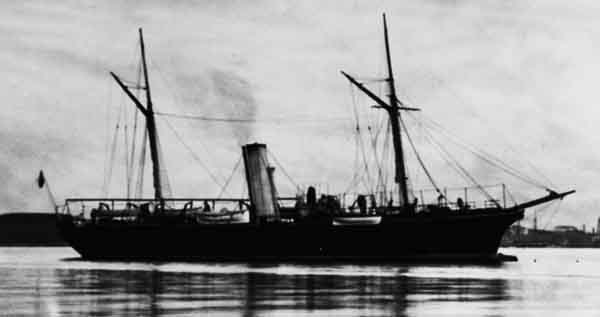
SMS Spalato
The Schiffbau-Kommission was hard at work to determine wether the new ship should carry the new Whitehead torpedoes or towed ones, what propulsion system it should use and sails, and the required speed. Eventually, the commission came out with four proposals:
-The largest was a 8,846 long tons vessel, 84 m long, armed with four 100-ton guns (caliber unknown, about 350 to 400 mm) and four torpedo tubes
-The second large model was a 3,200 long tons (3,300 t) vessel armed with two 24 cm guns, two machine guns and four torpedo tubes
-The third was a more modest 60 m, 1,230 long tons vessel armed still with two large 24 cm guns and four torpedo tubes.
-The fourth design was the most economical, but also the weakest, 52 m long for 736.6 long tons (748.4 t) and armed with just two 12 cm guns and four torpedo tubes.
A consensus was reached on the top speed, 15 knots (28 km/h; 17 mph), but also rigging, and two screws. The Artillerie-Kommission also made a high-speed proposal without any gus, just torpedo tubes, a paradox for such commission. The Torpedoversuchs-Kommission recommended submerged torpedo tubes and a ram bow, a substantial belt armor and two heavy gun turrets, as a sort of torpedo-ram such as found in the British and French navies. There were discussions indeed as if the new vessel should be a replacement for Ironclads.
In the end, a compromised was found and it was decided that the new ships should be built at purely torpedo-armed vessel, without armour or heavy guns.
In 1877, Pöck went to Germany to see trials of the torpedo-aviso SMS Zieten. It proved a great source of inspiration to draft the final blueprints.
Design of the Austro-Hungarian zara class
Pöck rejected Shipbuilding Engineer Andressen proposals from Schiffbau-Kommission in January 1877 to concentrate on a small design with characteristics agreed in March 1875, taken over by Josef von Romako, the Chief Constructor of the Austro-Hungarian Navy. In 1878 the design process was quickly finalized and blueprints were prepared, while construction started on 1 August. Romako was inspired by the German Zieten, but the local design was slower, heavier and bulkier. There was the added limitation of engines and boilers which could not tolerate as high a pressure as those in Zieten, and consumed more coal.
An unprotected schooner hull
The construction of SMS Zara was marked par an innovation, the first domestic use of Bessemer steel.
The first two ships, Zara and Spalato were 62.71 meters (205 ft 9 in) long overall, 55 m between perpendiculars for a 8.22 m (27 ft 0 in) beam and 4.1 m (13 ft 5 in) draught. The third, SMS Sebenico, was a bit later and her design was revised as slightly longer in order to meet the designed speed. She has been elongated to 64.91 m overall while her beam was slightly larger at 8.24 m for stability as the draft at 4.2 m. She displaced 882.6 long tons versus 833 tons standard for the first two. All three had the same crew of 13 officers and 135 enlisted men.
Propulsion: Struggles to reach the spec speed
The propulsion system counted on a pair of two-cylinder vertical compound steam engines. They were fed by by five coal-fired cylindrical fire-tube boilers. They were all ducted into a truncated single funnel amidships. Two bronze screws 2.74 m (9 ft 0 in) in diameter passed this power, but on trials, Zara can only reached 14.29 knots with 1,800 metric horsepower. This was almost the designed speed (15 knots) and she was also the fastest of the class.
SMS Spalato indeed failed miserably, only reaching at best 12.63 knots, under 1,370 PS and SMS Sebenico, supposed to be faster, was just a bit better at 12.81 knots on 1,598 PS (1,576 ihp). Each vessel had a barquentine rig with two masts for auxiliary propulsion as agreed. Sail area was 275.6 m2 (2,967 sq ft). Early service month quickly showed significant defects, such as excessive roll, insufficiently ventilation, her bow-mounted torpedo tube was not effective, and in general she was too slow to work as a scout, and too weak to be a torpedo boat flotilla leader.
Armament:
The gun armament comprised four single 90 mm/24 (3.5 in) rifled, breech-loading guns. This was completed by a single quick-firing 70 mm/15 (2.8 in) Krupp gun plus two 25 mm (0.98 in) rapid-fire Nordenfelt guns. SMS Zara and Spalato had the four torpedo tubes as designed, in single positions, two in the bow and one on either beam, both in deck-mounted launchers. SMS Sebenico differed with a single submerged bow-mounted torpedo tube.
Protection:
It was limited to the bare minimum: All three ships were given a thin 19 mm (0.75 in) armored deck.
Further modifications:
After they entered service it was estimated they should reach their design speed anyway and their machinery was taken in hands for an ovehaul. They all had their propeller shafts lengthened, and bronze screws replaced by larger steel propellers. First trials were disappointing however. SMS Sebenico was used as a prototype for more radical changes. Her stern was lengthened to improve her hydrodynamic shape. But the result was a mediocre improvement. At last between 1898 and 1901, they re-boilered, as the later built Lussin.
Armament Modifications
Additional 47 mm (1.9 in) guns were installed in the mid-1880s, a bow Hotchkiss revolver cannon and four more on the broadside. In 1897 SMS Spalato was converted as an artillery training school with one 12 cm/40 (4.7 in), two 15 cm/26 (5.9 in), one 47 mm/44, two 37 mm guns while two of her original 9 cm were removed. In 1901, all were removed, while she had two 12 cm, one 6.6 cm, two 47 mm, one 37 mm guns. SMS Sebenico received the same armament in 1903 but eight 47 mm (four 33 cal. and four 44 cal.) plus two 37 mm/23 and two 37 mm autocannon plus two 8 mm MGs and before 1914 an additional 10 cm (3.9 in) gun. The last to be modified, was SMS Zara, which in 1917 had two 6.6 cm, eight 47 mm/33/44 guns and only two bow torpedo tubes left.
Disappointing in service
All in all, these four ships proved almost useless in service. They had poor performance and cannot be used as fleet scouts or flotilla leaders. They were too weak also to protect rfriendly torpedo boats in that role or to be used as gunboats. The 1880s and 1890s saw them mostly inactive, reactivated for periodic training exercises. They usually alternated sea duty with training squadron and Harbor service.
Sebenico was used also as a training ship for engine-room personnel while Spalato found some use as an artillery school and Zara with the torpedo school. Zara however participated in a naval demonstration during Greco-Turkish War and Sebenico sank a Greek vessel trying to break the blockade. When WWI broke out they were all in training duties and became guard ships, seeing no action during the war, compounded by the usual caution of the Austro-Hungarian admiralty.
The Zara class in action
SMS Zara
In her sea trials, Zara reached 14.12 knots (26.15 km/h; 16.25 mph), less than the designed speed (15 knots) and replacing the propellers by larger steel ones did not improved much the top speed. On 17 July 1882, she was commissioned and in September, she participated in Pola in a demonstration of the fleet’s torpedo vessels in front of officials included Kaiser Franz Joseph I. He came onboard to see an action of torpedo boats sinking an old schooner. In 1885, the bow torpedo tube was replaced, and the next year, Zara was affected to the torpedo training school while an Hotchkiss 47 mm (1.9 in) gun was installed on her bow. and four more later in 1887.
Zara was in reserved, only activated for short training sessions. In 1889 she took part in the summer training cruise but was inactive from 1890 to March 1894. She assisted SS Palmyra after recommission, running aground off Medolino. She was back with the torpedo school in 1897, was re-boilered in 1898-99, to no avail since she can only reach 10.94 knots on trials, therefore she retuned in reserve in 1900. In 1903-1906, she was converted as a full time training ship, cruising along the Dalmatian coast until 1913. She was reduced to a tender for the same school, until May 1914, served with the naval cadets and converted into a guard ship on 28 June at Cattaro Bay until 1917. She was sent in Pola, but while she was cruising off the island of Lacroma, she suffered an accidental explosion, but made it to Ragusa for temporary repairs, and reached Pola for further repairs. She resumed her service with the training school until November 1918 and after peace was signed, allocated to Italy as war reparation, but soon scrapped in 1921.
SMS Spalato
SMS Spalato was modified soon after commission, her bow torpedo tube was modified, propulsion system rebuilt. By November 1884, started sea trials, but her machinery was damaged in an accident. Spalato proved slower than Zara at 12.63 knots and in 1886,she received a 47 mm Hotchkiss gun at the bow. She replaced Zara in the torpedo training school but until 1895 she was decommissioned and placed in reserve. She was reactivated periodically for summer exercizes in 1896 and 1897 and later joined the artillery school, rearmed with several 12 cm (4.7 in) and 15 cm (5.9 in) guns on the stern.
In 1900, she joined the reserve again, was re-boilered, rearmed, returned to the artillery school in 1902 until 1914. Decommissioned in March she was in poor state but served as a guard ship off Pola until May 1915. She was de-armed afterwards and allocated to Italy, scrapped in 1921.
SMS Sebenico
Despite her finer lines, SMS Sebenico sea trials were disappointing at 12.91 knots at maximum power, and from January 1884, she was assigned to the main Austro-Hungarian squadron. She toured in Greece and later spent the next nine years in reserve, rearmed with four 47 mm (1.9 in) guns. In August 1893 she went with the training squadron for engine-room personnel. She cruised to the island of Tenedos in 1895 and served as the station ship in Constantinople, until May 1896, and visited Piraeus, Greece in 1897.
She served with the International Squadron, which intervened in the 1897-1898 Greek uprising on Crete at a time the Austro-Hungarian was the third-largest contingent after UK and Italy. On 17 March 1898, she intercepted and sank a Greek schooner forcing the blockade off the island of Dia. She operated there until December 1898 but was decommissioned and disarmed when back home.
Until 1901, she was re-boilered and resumed her service as a boiler-room training ship, then station ship in Cattaro Bay by 1902, and a tender for the artillery school in 1903 with a revised armament. In January 1904 she assisted the Norddeutscher Lloyd steamship SS Calipso, stranded off Medolino. She served for training until May 1915, then station guard ship in the port of Spalato, then back to training in 1918, allocated to Italy in 1920 and scrapped.
The case of SMS Lussin (1883)
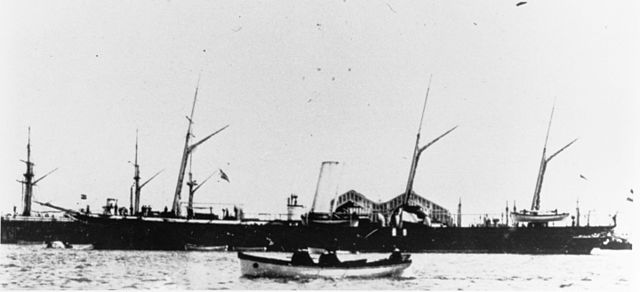
A revised design for speed
Seeing the first sea trials of the Zara as a disappointment, Josef von Romako, the chief engineer of the navy’s consteuction board started to design a fourth cruiser, helped by an other engineer, A. Waldvogel. Romako submitted it to the design staff of the maritime commission on 10 June 1881. The ship had a longer hull, finer lines, well shaped on the aft part in order to reach higher speeds. The longer hull also camed with revised propulsion system, rated at 3,600 metric horsepower (3,600 ihp) this time. Both combined were able to allow the ship to reach a top speed of 17 knots (31 km/h; 20 mph) this time. Eventually the Marinesektion gave to Stabilimento Tecnico Triestino in September 1881 the construction of the new ship.
However if Lussin was built and tested, she failed also too to meet the speed requirements of the Marinesektion. Therefore Vice Admiral Maximilian Daublebsky von Sterneck replaced Pöck in November 1883 and decided that future torpedo cruisers would always be ordered from foreign shipyards. This was to be the British-built Panther class, ordered in 1884, rather successful ships.
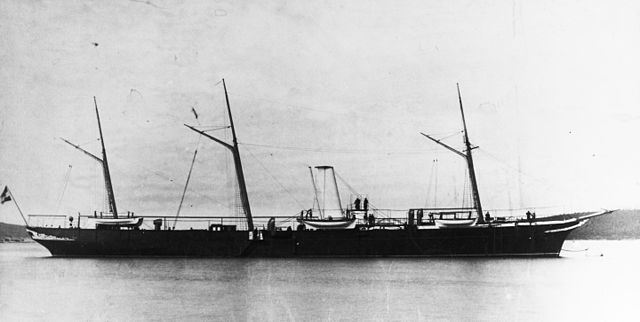
Disappointing speed but better armament
Lussin was longer at 79.75 m for 8.42 m in beam and a shallower draft of 4.06 m up to 4.3 m fully loaded. Displacement was also largely above the rest of the class at 1,011.17 metric tons (995.20 long tons; 1,114.62 short tons) as designed, and up to 1,122.5 t fully loaded. Propulsion reliaed on two 2-cylinder compound steam engines fed by five cylindrical boilers, for a total of 1,743.3 indicated horsepower. However as shown by trials she could only reach 12.14 knots on average and has to cruise at 11 knots in order to reach the range of 850 nautical miles (1,570 km; 980 mi). With boilers turned into blasting furnaces she could only produce 1,741.3 ihp (1,765.5 PS) for 12.95 knots. The machinery in fact poduced in the end less than half of what Waldvogel had preconised. Under sail she was in fact almost as fast at 12 knots (22 km/h; 14 mph). Main problems identified in the engine rooms were poor ventilation: After two hours, they overheating so much there was no choice left but left the machinery cooling down by pouring water on the boilers whenever possible.
Armament was more consistent for hunting torpedo boats, with two 15-cm/21 (5.9 in) installed in single mounts fore and aft, and one 66 mm/18 (2.6 in) that can be dismounted quickly and loaded into a boat, or a wheeled landing gun. SMS Lussin was also given five 47 mm (1.9 in) quick-firing guns in 1887 while she still counted on two bow-mounted submerged 35 cm (14 in) torpedo tubes. Protection was the same as other ships of the class, an armored deck 19 mm (0.75 in) thick.
A relatively inactive career
Lussin was laid down at Stabilimento Tecnico Triestino, San Rocco in September 1882. Delays prevented her initual launch in September 1883, and it was done on 22 December. Completion was also delayed later by a strike of the worker, a first in the Austro-Hungarian Navy. Towed to Pola on 12 July 1884 for fitting out she started in October her sea trials, until 21 February 1885 and commissioned the next day, cruising until 30 April in the southern Adriatic Sea. She was part of international naval demonstration in Greek waters and was back to Pola in 23 June 1885, seeing alternated training service and reserved periods. After being remived from front line service in 1890 she became a training ship for engine-room and boiler-room personnel but took part in annual fleet maneuvers. In 1893 she joined the Torpedo-boat Division, collided with the torpedo boat Tb 22 but resumed her routine training duties after repairs before running aground on reefs north of the island of Koločep in 1895.
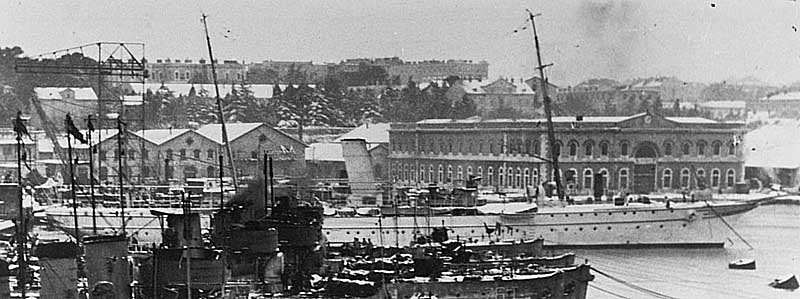
Lussin on 25 January 1917 in Pola. Note the hull was painted white or pale grey by that time. history.navy.mil collections
In 1896, she was reboilered, and resuemed her training duties until 1898, before becoming a mother ship for torpedo boats, although she was reactivated in February 1901 for training duties and in 1903 a station ship in Teodo, until 1909. After decommissioned the Marinetechnisches Komitee examined how SMS Lussin can be modified or be rebuilt as an admiralty yacht. In April 1910, she received a pair of MAN diesel engines (1,800 brake horsepower), allowing her to reach 14 knots (26 km/h; 16 mph), and she was recommissioned in 1913. In 1916 she was a barracks ship for German U-boat crews in Pola but was ceded to Italy as a war prize in 1920, shich rearmed her with four 7.6 cm/37 (3.0 in) AA guns, displacing 989/1,052 tonnes fully loaded, 14.7 knots fast from 3,255 bhp, recommissioned on 11 September 1924 as a depot ship for MAS motor torpedo boats named Sorrento. She was stricken in 1928, sold for scrap.
Read More/Src
Conway’s all the worlds fighting ships 1906-1921
https://en.wikipedia.org/wiki/Zara-class_cruiser_(1879)
A BRIEF HISTORY OF THE AUSTRIAN NAVY
Austria-Hungary, the Origins, and the First Year of World War I
Note: There is no known model kit of the Austro-Hungarian Zara class. If you know one, thanks for signalling it !


 Latest Facebook Entry -
Latest Facebook Entry -  X(Tweeter) Naval Encyclopedia's deck archive
X(Tweeter) Naval Encyclopedia's deck archive Instagram (@navalencyc)
Instagram (@navalencyc)





 French Navy
French Navy Royal Navy
Royal Navy Russian Navy
Russian Navy Armada Espanola
Armada Espanola Austrian Navy
Austrian Navy K.u.K. Kriegsmarine
K.u.K. Kriegsmarine Dansk Marine
Dansk Marine Nautiko Hellenon
Nautiko Hellenon Koninklije Marine 1870
Koninklije Marine 1870 Marinha do Brasil
Marinha do Brasil Osmanlı Donanması
Osmanlı Donanması Marina Do Peru
Marina Do Peru Marinha do Portugal
Marinha do Portugal Regia Marina 1870
Regia Marina 1870 Nihhon Kaigun 1870
Nihhon Kaigun 1870 Preußische Marine 1870
Preußische Marine 1870 Russkiy Flot 1870
Russkiy Flot 1870 Svenska marinen
Svenska marinen Søværnet
Søværnet Union Navy
Union Navy Confederate Navy
Confederate Navy Armada de Argentina
Armada de Argentina Imperial Chinese Navy
Imperial Chinese Navy Marinha do Portugal
Marinha do Portugal Mexico
Mexico Kaiserliche Marine
Kaiserliche Marine 1898 US Navy
1898 US Navy Sovietskiy Flot
Sovietskiy Flot Royal Canadian Navy
Royal Canadian Navy Royal Australian Navy
Royal Australian Navy RNZN Fleet
RNZN Fleet Chinese Navy 1937
Chinese Navy 1937 Kriegsmarine
Kriegsmarine Chilean Navy
Chilean Navy Danish Navy
Danish Navy Finnish Navy
Finnish Navy Hellenic Navy
Hellenic Navy Polish Navy
Polish Navy Romanian Navy
Romanian Navy Turkish Navy
Turkish Navy Royal Yugoslav Navy
Royal Yugoslav Navy Royal Thai Navy
Royal Thai Navy Minor Navies
Minor Navies Albania
Albania Austria
Austria Belgium
Belgium Columbia
Columbia Costa Rica
Costa Rica Cuba
Cuba Czechoslovakia
Czechoslovakia Dominican Republic
Dominican Republic Haiti
Haiti Hungary
Hungary Honduras
Honduras Estonia
Estonia Iceland
Iceland Eire
Eire Equador
Equador Iran
Iran Iraq
Iraq Latvia
Latvia Liberia
Liberia Lithuania
Lithuania Mandchukuo
Mandchukuo Morocco
Morocco Nicaragua
Nicaragua Persia
Persia San Salvador
San Salvador Sarawak
Sarawak Uruguay
Uruguay Venezuela
Venezuela Zanzibar
Zanzibar Warsaw Pact Navies
Warsaw Pact Navies Bulgaria
Bulgaria Hungary
Hungary

 Bundesmarine
Bundesmarine Dutch Navy
Dutch Navy Hellenic Navy
Hellenic Navy Marina Militare
Marina Militare Yugoslav Navy
Yugoslav Navy Chinese Navy
Chinese Navy Indian Navy
Indian Navy Indonesian Navy
Indonesian Navy JMSDF
JMSDF North Korean Navy
North Korean Navy Pakistani Navy
Pakistani Navy Philippines Navy
Philippines Navy ROKN
ROKN Rep. of Singapore Navy
Rep. of Singapore Navy Taiwanese Navy
Taiwanese Navy IDF Navy
IDF Navy Saudi Navy
Saudi Navy Royal New Zealand Navy
Royal New Zealand Navy Egyptian Navy
Egyptian Navy South African Navy
South African Navy






























 Ukrainian Navy
Ukrainian Navy dbodesign
dbodesign